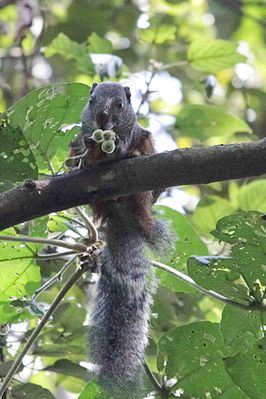Oil palm squirrel
| Oil palm squirrel | ||||||||||||
|---|---|---|---|---|---|---|---|---|---|---|---|---|

Common oil palm squirrel ( Protoxerus stangeri ) |
||||||||||||
| Systematics | ||||||||||||
|
||||||||||||
| Scientific name | ||||||||||||
| Protoxerus | ||||||||||||
| Forsyth Major , 1893 |
The oil palm squirrels ( Protoxerus ) are a genus of squirrels found in the African rainforests . They mostly live in the treetop region and are therefore rarely seen. A distinction is made between two types:
- Common oil palm squirrel , Protoxerus stangeri ( Waterhouse 1842 ), rainforests of West and Central Africa
- Slender-tailed squirrel , Protoxerus aubinnii ( Gray 1873 ), West Africa
features
The common oil palm squirrel has a distribution that includes all rainforests in Africa. It has a head body length of 30 cm, plus a tail about the same length. It is very variable in color: the back is olive brown to black; the cheeks and flanks are white; the underside is white to light brown. The tail can be banded in black and white or black and brown, or it can be monochrome. What is striking about this croissant is that the belly side is sparsely hairy, so that it appears almost naked.
In contrast, the slender-tailed squirrel has normal hair on the underside. It is a solid gray-brown color. Sometimes, but not always, a black line of eel runs down the back.
Way of life
Both species move vigorously through the treetops, looking for nuts and fruits. The eponymous preference for oil palms only exists in regions where these plants are widespread. There the squirrels are often found with orange spots on their fur, which are caused by the juice of the oil palm fruits.
While the common oil palm squirrel is one of the most common mammals of African rainforests, nothing is known about population numbers of the slender-tailed squirrel.
Systematics
The slender- tailed squirrel has occasionally been assigned to its own genus Allosciurus . Forsyth Major considered the two types of oil palm squirrels to be primitive members of the bristle squirrels , hence the generic name Protoxerus ( Xerus are the African bristle squirrels ) , which is still used today . However, according to current knowledge, they have nothing to do with these.
literature
- Ronald M. Nowak: Walker's Mammals of the World. 2 volumes. 6th edition. Johns Hopkins University Press, Baltimore MD et al. 1999, ISBN 0-8018-5789-9 .